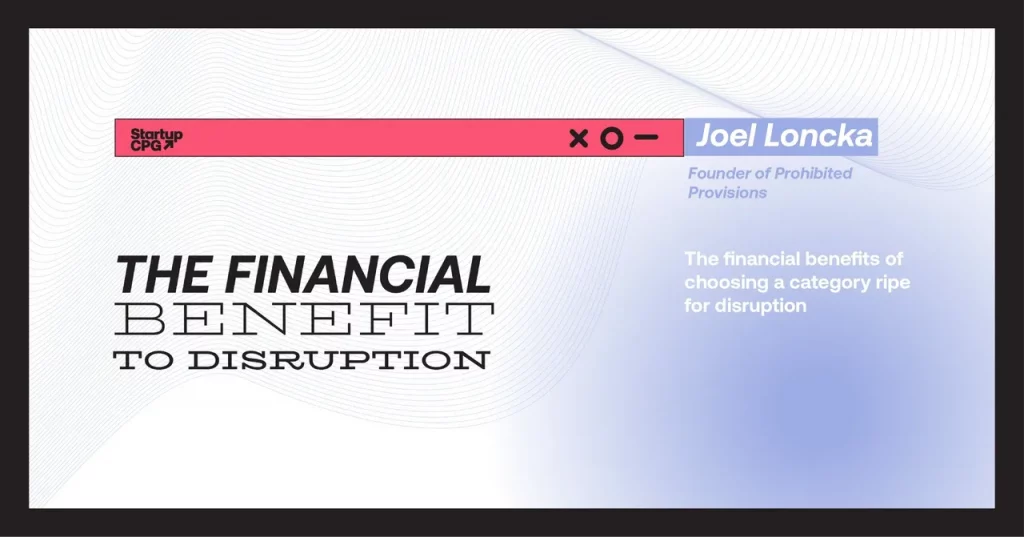The Financial Benefits of
Disruption
Joel Loncka is the founder of Denver based Prohibited Provisions, a creative cooking brand delivering unapologetic foods and flavors that enable people to be more rebellious in the kitchen and conveniently cook more creatively.
Plan ahead, build a product line that truly disrupts a latent category, and it will continually save your company money.
You have to spend money to make money
It’s cliché but it’s simply the truth.
If you aren’t new to CPG, it’s not a shock that the margins are small, it’s a volume industry, the hustle is real, building relationships are vital, and at some point, you will need to invest or raise significant capital to support your products the right way and grow. BUT, this doesn’t mean CPG brands can’t create significant efficiencies that enable healthy growth at lower costs than competitors.
The biggest opportunity happens before you even have a physical product
Yes, you need to solve a real need people care about.
Yes, it needs to be simple and intuitive.
Yes, you need to build a brand.
Yes, you need to have a clear path to healthy margins.
Yes, you need capital to grow and be successful.
But before you start investing heavily in product development take a moment, plan, and find opportunities that will truly create “positive disruption.” One of the best places to look are latent categories. If you look at some of the most successful brands, they most likely created positive disruption in a latent category versus trying to reinvent the wheel or create a completely new category.
By developing a product that creates positive disruption in a latent category you create efficiencies down the road and save money in multiple ways and help you grow. Here are the areas we at Prohibited Provisions are seeing this impact with our line of products.
- Less marketing and promotional spend needed in-store as our disruptive differentiation leads to unaided trial by consumers.
- Less time and roadblocks selling to buyers. The differentiation is clear, so our approvals were easier. Done correctly you will soon have buyers “knocking” on your door!
- Less influencer marketing spend, a good portion of influencers want new and different products to show their followers because they want to be viewed as the first to know. When your product is differentiated, you have negotiating power when working with influencers.
[Proof is the pudding]
I’m 35 and that headline just made me give a good laugh but it’s true and I don’t have a better saying for you, so we are rolling with it.
Don’t take my word for it, below are examples of brands that have been wildly successful, and a good portion of their success is due to positive disruption and planning before they even had a physical product. Capital is important, needed and something all these companies used to grow but proof if you put extra effort into finding latent category opportunities to disrupt it will make success a little easier.
Justin’s Peanut Butter – A sleepy latent category filled with traditional brands ripe for positive disruption by higher quality
Halo Top Ice Cream – Saturated category not changing with consumer tastes and needs.
Truff– Saturated category requiring bold moves and ripe for a premium brand in a world of craft brands and companies fighting over flavor variations and ingredients.
Haus Aperitifs – Capitalizing on changing US spirit drinking behaviors with a low ABV spirit that is easily accessible with DTC capabilities and designed to be an object that can fit into you home.
Vital Farms – A great branding case study of disruption. How many people have reached for the yellow carton that’s well designed because the egg industry decided to settle for a sea of sameness?
Other note able mentions: Smart Sweets, RX Bars, Dream Pops, Ugly Drinks, Daring,
So how do you discover disruption opportunities?
How do you find latent categories and opportunities to disrupt? There isn’t one answer but using a “tool kit” of prompts will help you to uncover these opportunities.
You can dive into the following questions/topics through your own personal experiences, tapping into feedback from friends/family, or even better getting feedback through consumer surveys.
Search for pain points or where people are unknowingly settling: From ingredients, to service, to lack of brand affinity in categories that are growing. Daily Harvest isn’t revolutionary but tapped into where people were settling on convenience and quality. What is an ingredient or product that people are disturbingly passionate about?
Where is there a clear love-hate dynamic you can tap into? Being able to tap into innate love for something is a big bonus for brands. Explore cultural nostalgic staples. Where is there an opportunity to put a modern spin on things? Mac n cheese stayed dormant for so many years… “homestyle” is not disruption.
What are big cultural behavior shifts happening and how can you get ahead of change in categories? People are shopping center store less and want fresher products. How can you disrupt the center of the store categories with fresh options that get placed on the perimeter of the store?
Keep your eyes open and stay on the lookout for opportunities to disrupt!






All Comments